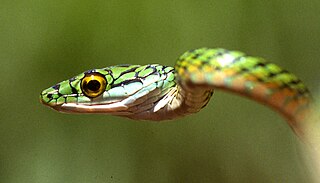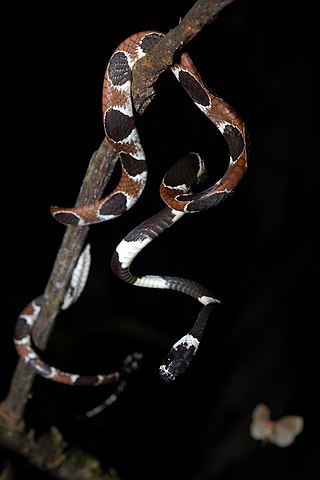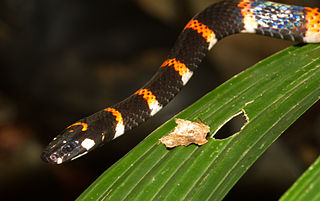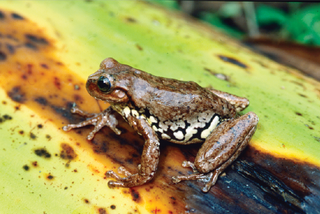
Xenosaurus is a genus of lizards; it is the only extant genus in the family Xenosauridae, with 14 species currently recognized. Also known as knob-scaled lizards, they can found in southwestern Tamaulipas and eastern Guerrero in Mexico. They can be found between 300 and 2,360 m of elevation in a wide variety of habitats ranging from xerophytic tropical scrub to cloud forest to tropical rainforest. Where they occupy moderately diverse places, including crevices and holes in limestone, spaces under volcanic boulders, crevices in volcanic rocks, karst limestone, limestone terrain, and hollow logs in dry areas where trees are sparse.

Abronia is a genus of lizards in the family Anguidae that is native to Mexico and Central America. The majority of the species are restricted to southern Mexico and Guatemala, but members of the genus occur as far south as Panama. They inhabit forests and woodlands, mostly in highlands, and some species are often associated with bromeliads. They are typically arboreal, but there are also terrestrial Abronia species. Many species are considered threatened due to habitat loss, killing by locals who mistakenly believe they are venomous, or collection for the captive reptile trade. They feed on small animal prey, such as insects, and the females give birth to live young.

Lepidophyma is a genus of lizards, commonly called tropical night lizards. The genus Lepidophyma is one of three genera of night lizards, which are a group of viviparous (live-bearing) lizards. There are 20 species of tropical night lizards in the genus Lepidophyma, making it the most populous night lizard genus. Species of the genus Lepidophyma are distributed throughout Central America, found anywhere from central Mexico to Panama, depending on the particular species. Tropical night lizards, particularly the yellow-spotted species, are sometimes called Central American bark lizards by pet dealers and owners.

Tantilla is a large genus of harmless New World snakes in the family Colubridae. The genus includes 66 species, which are commonly known as centipede snakes, black-headed snakes, and flathead snakes.

The Colubrinae are a subfamily of the family Colubridae of snakes. It includes numerous genera, and although taxonomic sources often disagree on the exact number, The Reptile Database lists 717 species in 92 genera as of September 2019. It is the second largest subfamily of colubrids, after Dipsadinae. Many of the most commonly known snakes are members of this subfamily, including rat snakes, king snakes, milk snakes, vine snakes, and indigo snakes.

Craugastor is a large genus of frogs in the family Craugastoridae with 126 species. Its scientific names means brittle-belly, from the Ancient Greek krauros and gastēr.
Geophis immaculatus, Downs's earth snake, is a small snake of the colubrid family. It is native to Mexico and Guatemala. There are no recognized subspecies. Although not much has been documented about it, the population distribution is in abundance and is of least concern in terms of conservation status.

Leptophis is a genus of colubrid snakes, commonly known as parrot snakes. The species within this genus are widely distributed throughout Mexico, Central and South America.

Dipsas is a genus of nonvenomous New World snakes in the subfamily Dipsadinae of the family Colubridae. The genus Sibynomorphus has been moved here. Species of the genus Dipsas are known as snail-eaters.

Dipsadinae is a large subfamily of colubroid snakes, sometimes referred to as a family (Dipsadidae). They are found in most of the Americas, including the West Indies, and are most diverse in South America. There are more than 700 species.

Apostolepis is a genus of snakes in the subfamily Dipsadinae. However, the familial placement differs among sources. It has also been placed in the family Colubridae, subfamily Dipsadinae or Xenodontinae, or in the family Xenodontidae. The genus Apostolepis is endemic to South America.

Rhadinaea is a genus of snakes of the family Colubridae.

Xenodon is a genus of New World snakes in the subfamily Dipsadinae of the family Colubridae.

Pliocercus euryzonus, commonly known as Cope's false coral snake, is a species of snake in the subfamily Dipsadinae of the family Colubridae. The species is indigenous to southeastern Central America and northwestern South America. There are two recognized subspecies.

Phalotris is a genus of snakes of the subfamily Dipsadinae. All species of the genus Phalotris are found in South America. The specific name, mertensi, is in honor of German herpetologist Robert Mertens. The specific name, normanscotti, is in honor of Norman Scott, Jr., in recognition of his contribution to the knowledge of the herpetofauna of Paraguay.

Geophis dunni, Dunn's earth snake, is a species of enigmatic snake in the family Colubridae. The species is presumably endemic to Nicaragua and is only known from a single specimen discovered in 1932. This specimen, the holotype, was discovered by Karl Patterson Schmidt in the stomach of a Central American coral snake, and no additional specimen has been seen since. The holotype has a snout-to-vent length (SVL) of 310 mm (12 in), a tail length of 57 mm (2.2 in), and a total length of 367 mm (14.4 in). It is part of the Geophis sieboldi species group according to Floyd Leslie Downs. This species was named by Schmidt after fellow herpetologist Emmett Reid Dunn "in allusion to his important contributions to our knowledge of this group of snakes".
Geophis championi, the Panamenian earth snake, is a species of snake in the family Colubridae. The species is endemic to Panama.

Sarcohyla is a genus of frogs in the family Hylidae. It is endemic to Mexico and is found in the montane parts of the country between Durango in the north and Guerrero in the south. These frogs typically occur in pristine habitats along streams in pine-oak woodland at elevations between 1,500 and 3,100 m above sea level. The generic name is derived from the Greek sarkodes meaning "fleshy" in combination with Hylas and refers to the thick, glandular skin characteristic of most of the species in the genus.
















